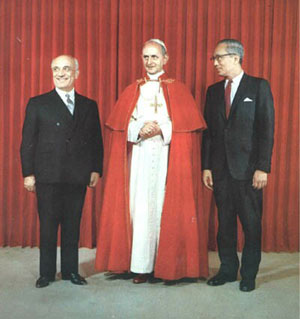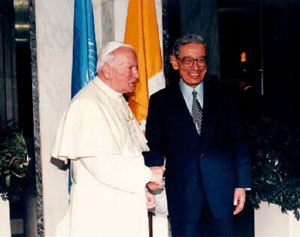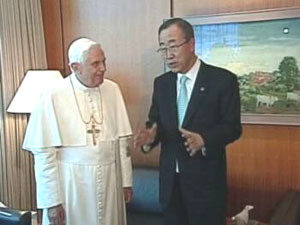 |
Church - State Relations
JPII & Dignitatis Humanae - IV
Final Questions a Catholic Cannot Evade
Julio Alvear, Ph.D.
As the official documents show us, it is certain that John Paul II taught the right to religious liberty of a positive content with the elements we have stressed, formulated under the perspective of the conciliar hermeneutic of Dignitatis humanae. It thus results that the basis of any reexamination of its continuity with the Magisterium of the Church must situate itself on a different terrain.
1. A traditional interpretation of Dignitatis humanae is possible only if the teaching of John Paul II is restricted to the concept of liberty of conscience - which he identifies at times with the right to religious liberty - especially taking into account the presuppositions we pointed out in the Encyclical Veritatis splendor and the explanation of the Catechism of the Catholic Church on the topic. (1) However, this is not the summit of his teaching but rather only its starting point.



The Conciliar Popes at the UN - A religious liberty at variance with the Catholic doctrine |
2. Respect for the truth forces us to admit that this summit is a broadening of the positive concept of the right to religious liberty. I do not intend to discuss here whether it is possible to adopt a “traditional” interpretation of Dignitatis humanae, like that made in their time by Victorino Rodriguez, O.P., Brian Harrison, and more recently by F. Ocáriz and Basile Valuet, O.S.B. (2)
In any case, John Paul II gave an answer to this question through his teaching, and the response is gravely negative. Certainly there is a possibility that citations could be chosen to make a non-problematic doctrinal presentation, that is to say, to make his teaching appear in almost perfect harmony with the doctrine of St. Thomas and the Popes who energetically condemned both the errors of the “new rights” and the “modern liberties.”
But it must be admitted that such a presentation would raise the laughter of all the heads of States and international organizations as well as all the religious leaders and social groups addressed by John Paul II. For he spoke to them delivering a very clear message in his fundamental orientation, including an explicit modern doctrine on religious liberty of a positive content that followed the ecumenical and humanist ideals of our times.
3. In this domain, we must ask ourselves to what measure and extent the doctrine of the right to religious liberty as professed by John Paul II in his continuous teaching can condition the response to the appeal made by Benedict XVI to reread the texts of the Council - and therefore also Dignitatis humanae - according to a “hermeneutic of continuity.” Part of the answer can be found in the teaching of Benedict XVI himself on the topic: Did he not follow the same path of his predecessor on this topic?
4. For a lay Catholic doing research on this subject, other questions appear:
- To what degree is the doctrine on the right to religious liberty of a positive content different from Catholic tradition, which never recognized - and in fact could not recognize - the right of man to walk on a path that diverges from the true Religion established by God Himself?
- If this is the doctrine that Church teaching supports after the Council, does this mean that a false religion objectively has a moral right - juridically recognized - to be publicly professed in equal rank with the true Religion?
- Does not, then, the political structure of a Catholic society have in principle the moral and juridical right to publicly profess the Faith, and base its laws and principles of its action on it?
These questions require a profound clarification of the Magisterium.
1.See notes 4 and 5 in the article JPII & Dignitatis Humanae – II, The Contours of Liberty of Conscience according to John Paul II.
2.Cf. Dom Basile Valuet, O.S.B., La Liberté Religieuse et la Tradiiton Catholique. Un cas de development doctrinal homogène dans le magistère auhtentique (Le Barroux: Abbaye Sainte Madeleine, 1998), 3 vols. Based on documents the author attempts to prove that the confessional State is referred to in the text of DH and is compatible with the teaching of John Paul II.
Unfortunately, regarding the latter, the work of Dom Basile is incomplete. First, because of insufficient sources. The author, who aims to make a detailed examination of the teaching of John Paul II, bases his work on only 151 texts, omitting 442, whose existence he acknowledges in the second edition of his work (vol. 2, pp. 1424-1437), without analyzing them, except two. Second, generally speaking, besides his insufficient selection of texts, Dom Basile does not exploit those documents that give an in depth understanding of John Paul II’s thinking on religious liberty in the dynamic and broad sense like we have done here.
Article first published in the magazine Catholica, Paris, Spring 2009
Posted January 18, 2013


Related Topics of Interest
 JPII's Hermeneutic Criteria for Dignitatis Humanae JPII's Hermeneutic Criteria for Dignitatis Humanae
 The Contours of Liberty of Conscience According to JPII The Contours of Liberty of Conscience According to JPII
 John Paul II Adopts the Goals of the UN John Paul II Adopts the Goals of the UN
 Vatican II Turnaround on the Church-State Relationship Vatican II Turnaround on the Church-State Relationship
 Vatican II's Position on Religious Liberty Vatican II's Position on Religious Liberty
 JPII Praises Liberty, Equality & Fraternity JPII Praises Liberty, Equality & Fraternity
 Pius VI: Religious Liberty Is a ‘Monstrous Right’ Pius VI: Religious Liberty Is a ‘Monstrous Right’
 Gregory XVI: Liberty of Conscience Is a ‘Delirium’ Gregory XVI: Liberty of Conscience Is a ‘Delirium’

Related Works of Interest
|
|
Church-State | Cultural | Home | Books | CDs | Search | Contact Us | Donate

© 2002- Tradition in Action, Inc. All Rights Reserved
|
 |

|